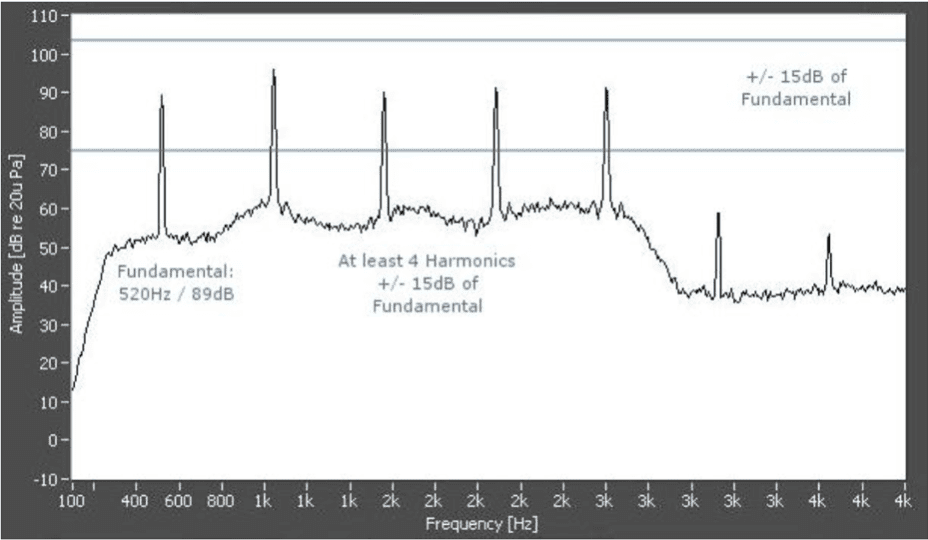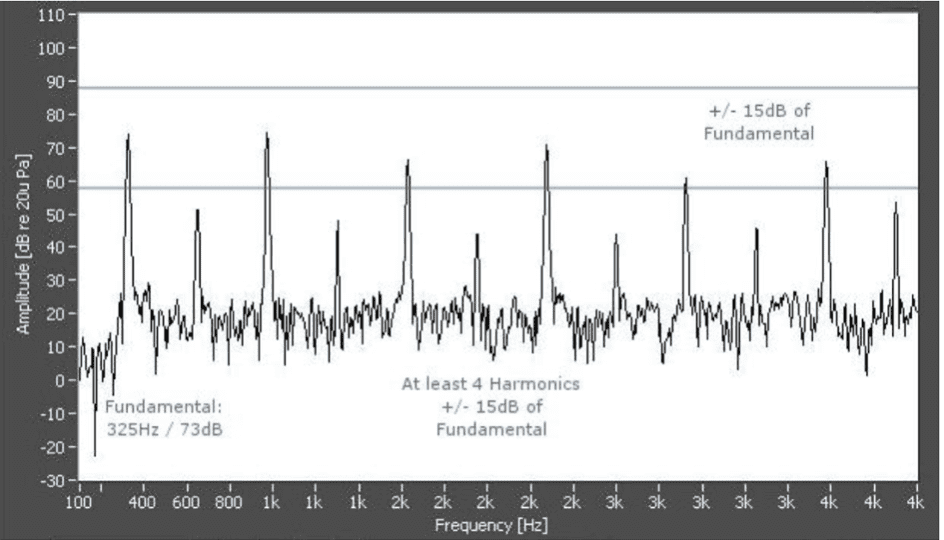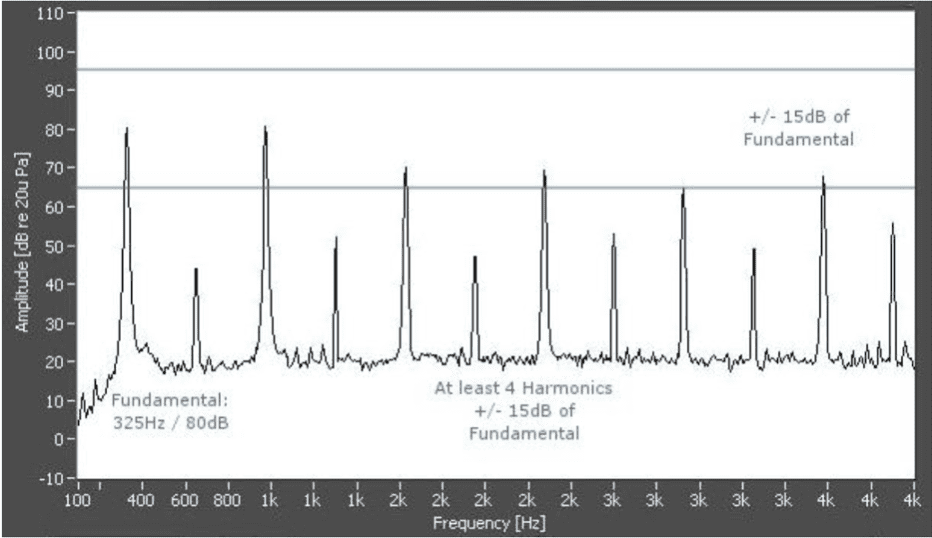
How to Choose the Right IEC 60601-1-8 Speaker
With the increased use of medical electronics in medicine today, the International Electrotechnical Commission (IEC) developed the IEC 60601-1-8 standard to regulate alarm signals to prevent confusion, when several instruments are sounding at the same time in the same room.
While the IEC 60601-1-8 standard covers every aspect on the alarm signals, and should be referred to as the ultimate reference with regards to the specific tones to use in your device, there are three main requirements that pertain to speaker selection:
- A pulsed frequency between 150 Hz and 1 kHz
- At minimum of four harmonics of the pulsed frequency between 300 Hz and 4 kHz
- The sound pressure level (SPL) of the harmonics must be within ±15 dB of the pulsed frequency
Additional pulse requirements—such as pulse duration, rise time, and fall time—are also part of this standard, but pertain more to the input signal sent to the speaker.
Below is an example of the type of waveform characteristics* that may be used to meet the IEC 60601-1-8 criteria. The flat portion of the waveform is used to create the harmonics from the fundamental pulsed frequency.

*For informational purposes only
PUI Audio has taken the performance criteria called out by IEC 60601-1-8 and performed studies on speakers to gauge which specifications stand out as most important when selecting speakers to meet the criteria.
Each test below was performed with the speaker mounted to a test baffle, and a B&K measurement microphone connected to a Listen, Inc. SoundCheck test system set to spectral analyzer mode.
 AS06608PS-R with 1W, 520 Hz square wave AS06608PS-R with 1W, 520 Hz square waveMicrophone spaced at 10cm from test baffle |
 AS04508MR-3-R with 1W, 325 Hz square wave AS04508MR-3-R with 1W, 325 Hz square waveMicrophone spaced at 10cm from test baffle |

AS04004PO-R with 1W, 325 Hz square wave |

AS02808MR-R with 1W, 325 Hz square wave |
From our testing, we can deduce the characteristics of a speaker that makes it an ideal candidate to use within a Medical Device that needs to meet the criteria set forth by IEC 60601-1-8.
Steps to selecting the ideal speaker for your application:
1. Reference IEC 60601-1-8 to ensure correct tone selection for your product. Below is an example of tonal requirements* for different product applications.
| Cause | Medium Priority | High Priority | Mnemonic Notes | Examples of type of Alarm System |
| General | C C C | C C C – C C | Fixed Pitch | Other Alarm Systems that do not readily fall into one of the following categories, including but not limited to electrical or non-oxygen gas supply systems, EEG monitors, intracranial pressure monitors, laparoscopic gas insufflation systems, calf compressor systems, etc. Optionally this sound is permitted for the Alarm System of any kind of equipment. |
| Cardiac | c e g | c e g – g C | Trumpet call; Call to arms; Major chord | Anesthesia workstations that include cardiac monitors, multi-parameter monitors which include cardiac monitors, heart rate monitors, invasive or non-invasive blodd pressure monitors, cardiac output monitors, peripheral perfusion monitors (plethysmographs), transesophageal echo, fetal heart rate monitors. |
| Ventilation | c a f | c a f – a f | Inverted major chord; Rise and fall of the lungs | Anesthesia workstations which include ventilators (but which do not include cardiac monitors); lung ventilators, spirometers, CO2 monitors, ventilator disconnect (airway pressure) monitors, etc. |
| Oxygen | C b a | C b a – g f | Slowly falling pitches; Top of a major scale; Falling pitch of an oximeter | Pulse oximeters, transcutaneous / tissue oxygen monitors, oxygen analyzers, oxygen concentrators, oxygen gas supply lines. |
| Drug or Fluid Delivery | C d g | C d g – C d | Jazz chord (inverted 9th); Drops of an infusion falling and “splashing” back up | Volumetric infusion pumps, syringe drivers, anesthetic agent delivery systems or analyzers. |
| Equipment or Supply Failure | C c c | C c c – C c | Falling or dropping down | Any device when it experiences loss of power or other major failure of the device. |
2. Convert the tones into their respective frequency. Use this musical note to frequency conversion chart to assist you.
3. Based upon the lowest musical note’s frequency (where C4, or middle C, would be ~261 Hz), you would start filtering for speakers with a resonant frequency of 261 Hz or lower.
4. If you need to meet a target SPL—70 dB at 1 meter is a good rule-of-thumb—you would then additionally filter for speakers that can achieve that SPL while observing the speaker’s power rating.
Speaker Integration Best Practices
- If possible, mount the speaker to the inside face of the outer housing. This maximizes the speaker’s measured output. Leave a keep-out area of at least 3mm between the speaker’s diaphragm and the surface in front of it.
- Ensure that the speaker is mounted in such a way to create a seal along the outer edges of the speaker’s frame. This reduces cancelation that occurs if the front of the speaker’s diaphragm/cone can interact with the back of the diaphragm/cone. Cancelation can cause a reduction in output below 1 kHz.
- As the signal to the speaker is a trapezoidal waveform, or a square wave, power handling needs to be calculated using the formula below. Do not exceed the rated power (not the maximum instantaneous power, which is meant for use with voice or music) of the speaker.
Power = (Volts peak)2 / Impedance
Exceeding the speaker’s rated power will cause damage over time. Typically the type of damage will be broken voice coil tinsel leads or a burned voice coil that causes open load resistance, or a deformed voice coil former which locks the voice coil in the magnetic motor. - Mounting the speaker within an enclosure will improve performance at and below the resonant frequency of a speaker. Please contact PUI Audio for more information regarding the correct enclosure volume for your application.
- If your application will be chemically cleaned in a hospital environment, choose a speaker that has been treated (our WR series speakers) or a speaker with a Mylar or aluminum diaphragm.
Recommended Speakers
PUI Audio is the go-to speaker source for medical applications. Decades of experience in assisting the world’s leading Medical Device manufacturers allows us to recommend the following speakers for IEC 60601-1-8 devices:
Hi Fidelity & Superior Frequency Response:
| Part Number | Dimensions (in mm) | Resonant Frequency | SPL @ 10cm at Rated Power | SPL @ 1m at Rated Power |
| AS02704MS-N50-LW100-R | 27L x 27W x 6.6H | 350 Hz | 96 dB | 76 dB |
| AS03204MS-3-R (4 ohm)
AS03208MS-3-R (8 ohm) |
32.7L x 31.7W x 16.5H | 200 Hz | 101 dB | 81 dB |
| AS03604MR-N50-R | 36D x 18H | 200 Hz | 103 dB | 83 dB |
| AS06004PS-R (4 ohm)
AS06008PS-R (8 ohm) |
66.8L x 66.8W x 26.5H | 160 Hz | 109 dB | 89 dB |
| AS09208AR-R | 92D x 44.6H | 90 Hz | 112 dB | 92 dB |
| AS03608AS-R | 36L x 36W x 16.8H | 250 Hz | 98 dB | 78 dB |
| AS05308AS-R | 53L x 53W x 34H | 230 Hz | 108 dB | 88 dB |
| AS06504PS-X-R | 65.0L x 65.0W x 36.7H | 130 Hz | 111 dB | 91 dB |
Lead-Wired and/or Enclosed for Ease of Use:
| Part Number | Dimensions (in mm) | Resonant Frequency | SPL @ 10cm at Rated Power | SPL @ 1m at Rated Power |
| AS02008MR-LW152-R | 20D x 3H | 500 Hz | 93 dB | 73 dB |
| AS02808MR-LW152-R | 28D x 5.2H | 500 Hz | 95 dB | 75 dB |
| AS03608MR-LW100-R | 36D x 4.6H | 500 Hz | 101 dB | 81 dB |
| AS04004PO-2-LW152-WR-R | 40L x 28.5W x 11.7H | 420 Hz | 100 dB | 80 dB |
| ASE04508MR-LW150-WP-R | 45L x 36W x 20H* | 420 Hz | 98 dB | 78 dB |
| AS06608MR-LW152-R | 66L x 66W x 12.5H | 380 Hz | 101 dB | 81 dB |
| AS07104PO-LW152-R (4 ohm)
AS07108PO-LW152-R (8 ohm) |
71L x 41W x 25H | 250 Hz | 104 dB | 84 dB |
| ASE06008MR-LW150-R | 60L x 30W x 10.3H* | 300 Hz | 101 dB | 81 dB |
*Denotes speaker with enclosure
Rugged and Durable for Element Resistance:
| Part Number | Dimensions (in mm) | Resonant Frequency | SPL @ 10cm at Rated Power | SPL @ 1m at Rated Power |
| AS04004MR-N50-WP-R | 40D x 21.5H | 160 Hz | 105 dB | 85 dB |
| AS04504PS-X-R | 45.4L x 43.3W x 29.2H | 170 Hz | 110 dB | 90 dB |
| AS05804PS-X-R | 58.3L x 55.3W x 33.8H | 140 Hz | 109 dB | 89 dB |
| AS04004PO-2-WR-R | 40L x 28.5W x 11.7H | 420 Hz | 106 dB | 86 dB |
| AS04004PR-WR-R | 40L x 40W x 17.5H | 180 Hz | 104 dB | 84 dB |
| AS04008PS-4W-WR-R | 40L x 28.3W x 11.5H | 380 Hz | 101 dB | 81 dB |
| AS06608PS-WR-R | 66.3L x 66.3W x 29H | 230 Hz | 115 dB | 95 dB |
| AS07104PO-LW152-WR-R (4 ohm)
AS07108PO-LW152-WR-R (8 ohm) |
71L x 41W x 25H | 250 Hz | 104 dB | 84 dB |